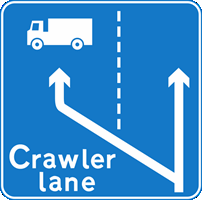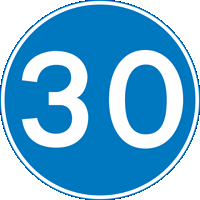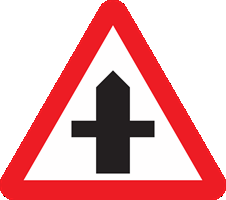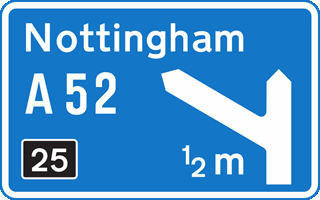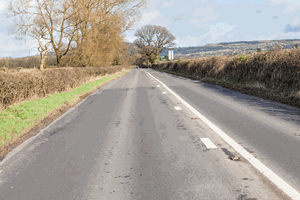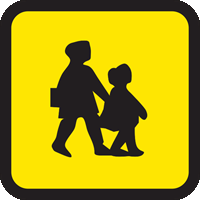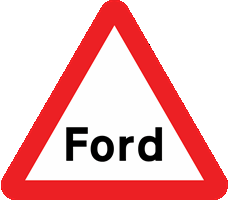You have 57 minutes to answer 50 multiple choice theory test questions. You need to answer at least 43 out of 50 questions correctly to pass. You can review your answer after each question or you can review all of your answers at the end of the test. Best of luck!
Test Quick View
Click on an answer to view the correct choice along with the explanation.
Correct Answer: B
Explanation: If you want to make a U-turn, slow down and ensure that the road is clear in both directions. Make sure that the road is wide enough to carry out the manoeuvre safely.
Explanation: If you want to make a U-turn, slow down and ensure that the road is clear in both directions. Make sure that the road is wide enough to carry out the manoeuvre safely.
Correct Answer: A
Explanation: On a motorway all traffic should use the left-hand lane unless overtaking. Use the centre or right-hand lanes if you need to overtake. If you're overtaking a number of slower vehicles move back to the left-hand lane when you're safely past. Check your mirrors frequently and don't stay in the middle or right-hand lane if the left-hand lane is free
Explanation: On a motorway all traffic should use the left-hand lane unless overtaking. Use the centre or right-hand lanes if you need to overtake. If you're overtaking a number of slower vehicles move back to the left-hand lane when you're safely past. Check your mirrors frequently and don't stay in the middle or right-hand lane if the left-hand lane is free
Correct Answer: D
Explanation: Slow-moving, large vehicles might slow down the progress of other traffic. On a steep gradient this extra lane is provided for these slow-moving vehicles to allow the faster-moving traffic to flow more easily.
Explanation: Slow-moving, large vehicles might slow down the progress of other traffic. On a steep gradient this extra lane is provided for these slow-moving vehicles to allow the faster-moving traffic to flow more easily.
B
C
D
Correct Answer: A
Explanation: There are times where road markings can be obscured by queuing traffic, or you might be unsure which lane you need to be in. If you realise that you're in the wrong lane, don't cut across lanes or bully other drivers to let you in. Follow the lane you're in and find somewhere safe to turn around if you need to.
Explanation: There are times where road markings can be obscured by queuing traffic, or you might be unsure which lane you need to be in. If you realise that you're in the wrong lane, don't cut across lanes or bully other drivers to let you in. Follow the lane you're in and find somewhere safe to turn around if you need to.
Correct Answer: C
Explanation: This sign is shown where slow-moving vehicles would impede the flow of traffic, for example in tunnels. However, if you need to slow down or even stop to avoid an incident or potential collision, you should do so.
Explanation: This sign is shown where slow-moving vehicles would impede the flow of traffic, for example in tunnels. However, if you need to slow down or even stop to avoid an incident or potential collision, you should do so.
Correct Answer: B
Explanation: The priority through the junction is shown by the broader line. You need to be aware of the hazard posed by traffic crossing or pulling out onto a major road.
Explanation: The priority through the junction is shown by the broader line. You need to be aware of the hazard posed by traffic crossing or pulling out onto a major road.
7. These flashing red lights mean STOP. In which THREE of the following places could you find them?
Mark three answers
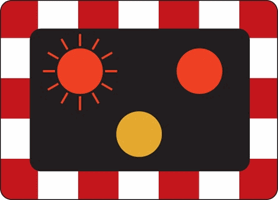
B
C
D
E
F
Correct Answer: A, B, C
Explanation: You must always stop when the red lights are flashing, whether or not the way seems to be clear.
Explanation: You must always stop when the red lights are flashing, whether or not the way seems to be clear.
Correct Answer: B
Explanation: Before you set out on your journey use a road map to plan your route. When you see advance warning of your junction, make sure you get into the correct lane in plenty of time. Last-minute harsh braking and cutting across lanes at speed is extremely hazardous.
Explanation: Before you set out on your journey use a road map to plan your route. When you see advance warning of your junction, make sure you get into the correct lane in plenty of time. Last-minute harsh braking and cutting across lanes at speed is extremely hazardous.
9. You are towing a small trailer on a busy three-lane motorway. All the lanes are open. You must
Mark two answers
B
C
D
Correct Answer: B, D
Explanation: You should be aware of the motorway regulations for vehicles towing trailers. These state that a vehicle towing a trailer must not
- use the right-hand lane of a three-lane motorway unless directed to do so, for example, at roadworks or due to a lane closure,
- exceed 60 mph.
Explanation: You should be aware of the motorway regulations for vehicles towing trailers. These state that a vehicle towing a trailer must not
- use the right-hand lane of a three-lane motorway unless directed to do so, for example, at roadworks or due to a lane closure,
- exceed 60 mph.
Correct Answer: C
Explanation: You MUST NOT park or stop on a road marked with double white lines (even where one of the lines is broken) except to pick up or set down passengers.
Explanation: You MUST NOT park or stop on a road marked with double white lines (even where one of the lines is broken) except to pick up or set down passengers.
Correct Answer: B
Explanation: Temporary restrictions on motorways are shown on signs which have flashing amber lights. At the end of the restriction you will see this sign without any flashing lights.
Explanation: Temporary restrictions on motorways are shown on signs which have flashing amber lights. At the end of the restriction you will see this sign without any flashing lights.
Correct Answer: A
Explanation: By law you must not sound your horn in a built-up area between 11.30 pm and 7.00 am. The exception to this is when another road user poses a danger.
Explanation: By law you must not sound your horn in a built-up area between 11.30 pm and 7.00 am. The exception to this is when another road user poses a danger.
Correct Answer: D
Explanation: Watch out for children crossing the road from the other side of the bus.
Explanation: Watch out for children crossing the road from the other side of the bus.
14. You are following two cyclists. They approach a roundabout in the left-hand lane. In which direction should you expect the cyclists to go?
Mark one answer
B
C
D
Correct Answer: A
Explanation: Cyclists approaching a roundabout in the left-hand lane may be turning right but may not have been able to get into the correct lane due to the heavy traffic. They may also feel safer keeping to the left all the way round the roundabout. Be aware of them and give them plenty of room.
Explanation: Cyclists approaching a roundabout in the left-hand lane may be turning right but may not have been able to get into the correct lane due to the heavy traffic. They may also feel safer keeping to the left all the way round the roundabout. Be aware of them and give them plenty of room.
15. You are signalling to turn right in busy traffic. How would you confirm your intention safely?
Mark one answer
B
C
D
Correct Answer: B
Explanation: In some situations you may feel your indicators cannot be seen by other road users. If you think you need to make your intention more clearly seen, give the arm signal shown in The Highway Code.
Explanation: In some situations you may feel your indicators cannot be seen by other road users. If you think you need to make your intention more clearly seen, give the arm signal shown in The Highway Code.
Correct Answer: D
Explanation: The white line is generally positioned so that pedestrians have room to cross in front of waiting traffic. Don't move off while pedestrians are crossing, even if the lights change to green.
Explanation: The white line is generally positioned so that pedestrians have room to cross in front of waiting traffic. Don't move off while pedestrians are crossing, even if the lights change to green.
Correct Answer: C
Explanation: When stationary only sound your horn if you think there is a risk of danger from another road user. Don't use it just to attract someone's attention. This causes unnecessary noise and could be misleading.
Explanation: When stationary only sound your horn if you think there is a risk of danger from another road user. Don't use it just to attract someone's attention. This causes unnecessary noise and could be misleading.
Correct Answer: D
Explanation: Check your tyre pressures frequently - normally once a week. If pressures are lower than those recommended by the manufacturer, there will be more ‘rolling resistance'. The engine will have to work harder to overcome this, leading to increased fuel consumption.
Explanation: Check your tyre pressures frequently - normally once a week. If pressures are lower than those recommended by the manufacturer, there will be more ‘rolling resistance'. The engine will have to work harder to overcome this, leading to increased fuel consumption.
19. You are on a road which has speed humps. A driver in front is travelling slower than you. You should
Mark one answer
B
C
D
Correct Answer: C
Explanation: Be patient and stay behind the car in front. Normally you should not overtake other vehicles in traffic-calmed areas. If you overtake here your speed may exceed that which is safe along that road, defeating the purpose of the traffic calming measures.
Explanation: Be patient and stay behind the car in front. Normally you should not overtake other vehicles in traffic-calmed areas. If you overtake here your speed may exceed that which is safe along that road, defeating the purpose of the traffic calming measures.
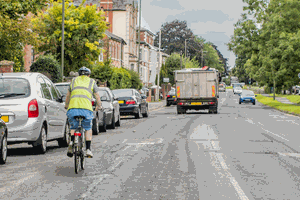
B
C
D
Correct Answer: C
Explanation: When following a cyclist be aware that they have to deal with the hazards around them. They may wobble or swerve to avoid a pothole in the road or see a potential hazard and change direction suddenly. Don't follow them too closely or rev your engine impatiently.
Explanation: When following a cyclist be aware that they have to deal with the hazards around them. They may wobble or swerve to avoid a pothole in the road or see a potential hazard and change direction suddenly. Don't follow them too closely or rev your engine impatiently.
B
C
D
Correct Answer: C
Explanation: If you want to overtake a long vehicle, stay well back so that you can get a better view of the road ahead. The closer you get the less you will be able to see of the road ahead. Be patient, overtaking calls for sound judgement. DON'T take a gamble, only overtake when you are certain that you can complete the manoeuvre safely.
Explanation: If you want to overtake a long vehicle, stay well back so that you can get a better view of the road ahead. The closer you get the less you will be able to see of the road ahead. Be patient, overtaking calls for sound judgement. DON'T take a gamble, only overtake when you are certain that you can complete the manoeuvre safely.
22. The dual carriageway you are turning right onto has a very narrow central reservation. What should you do?
Mark one answer
B
C
D
Correct Answer: D
Explanation: When the central reservation is narrow you should treat a dual carriageway as one road. Wait until the road is clear in both directions before emerging to turn right. If you try to treat it as two separate roads and wait in the middle, you are likely to cause an obstruction and possibly a collision
Explanation: When the central reservation is narrow you should treat a dual carriageway as one road. Wait until the road is clear in both directions before emerging to turn right. If you try to treat it as two separate roads and wait in the middle, you are likely to cause an obstruction and possibly a collision
23. Traffic officers operate on motorways and some primary routes in England. What are they authorised to do?
Mark one answer
B
C
D
Correct Answer: D
Explanation: Traffic officers do not have enforcement powers but are able to stop and direct people on motorways and some 'A' class roads. They only operate in England and work in partnership with the police at incidents, providing a highly trained and visible service. They are recognised by an orange and yellow jacket and their vehicle has yellow and black markings
Explanation: Traffic officers do not have enforcement powers but are able to stop and direct people on motorways and some 'A' class roads. They only operate in England and work in partnership with the police at incidents, providing a highly trained and visible service. They are recognised by an orange and yellow jacket and their vehicle has yellow and black markings
24. You should not normally travel on the hard shoulder of a motorway. When can you use it?
Mark one answer
B
C
D
Correct Answer: A
Explanation: Normally you should only use the hard shoulder for emergencies and breakdowns, and at roadworks when signs direct you to do so. Active Traffic Management (ATM) areas are being introduced to ease traffic congestion. In these areas the hard shoulder may be used as a running lane when speed limit signs are shown directly above.
Explanation: Normally you should only use the hard shoulder for emergencies and breakdowns, and at roadworks when signs direct you to do so. Active Traffic Management (ATM) areas are being introduced to ease traffic congestion. In these areas the hard shoulder may be used as a running lane when speed limit signs are shown directly above.
B
C
D
Correct Answer: A
Explanation: Avoiding busy times means that you are not adding needlessly to traffic congestion. Other advantages are that you will use less fuel and feel less stressed.
Explanation: Avoiding busy times means that you are not adding needlessly to traffic congestion. Other advantages are that you will use less fuel and feel less stressed.
Correct Answer: D
Explanation: A ford is a crossing over a stream that's shallow enough to go through. After you've gone through a ford or deep puddle the water will affect your brakes. To dry them out apply a light brake pressure while moving slowly. Don't travel at normal speeds until you are sure your brakes are working properly again.
Explanation: A ford is a crossing over a stream that's shallow enough to go through. After you've gone through a ford or deep puddle the water will affect your brakes. To dry them out apply a light brake pressure while moving slowly. Don't travel at normal speeds until you are sure your brakes are working properly again.
27. Powered vehicles, such as wheelchairs or scooters, used by disabled people have a maximum speed of
Mark one answer
B
C
D
Correct Answer: D
Explanation: These are small battery powered vehicles and include wheelchairs and mobility scooters. Some are designed for use on the pavement only and have an upper speed limit of 4 mph (6 km/h). Others can go on the road as well and have a speed limit of 8 mph (12 km/h). They are now very common and are generally used by the elderly, disabled or infirm. Take great care as they are extremely vulnerable because of their low speed and small size.
Explanation: These are small battery powered vehicles and include wheelchairs and mobility scooters. Some are designed for use on the pavement only and have an upper speed limit of 4 mph (6 km/h). Others can go on the road as well and have a speed limit of 8 mph (12 km/h). They are now very common and are generally used by the elderly, disabled or infirm. Take great care as they are extremely vulnerable because of their low speed and small size.

B
C
D
E
Correct Answer: A, B
Explanation: A stationary bus at a bus stop can hide pedestrians just in front of it who might be about to cross the road. Only go past at a speed that will enable you to stop safely if you need to.
Explanation: A stationary bus at a bus stop can hide pedestrians just in front of it who might be about to cross the road. Only go past at a speed that will enable you to stop safely if you need to.
29. Following a collision someone has suffered a burn. The burn needs to be cooled. What is the shortest time it should be cooled for?
Mark one answer
B
C
D
Correct Answer: C
Explanation: Check the casualty for shock and if possible try to cool the burn for at least 20 minutes. Use a clean, cold non-toxic liquid preferably water.
Explanation: Check the casualty for shock and if possible try to cool the burn for at least 20 minutes. Use a clean, cold non-toxic liquid preferably water.
Correct Answer: A
Explanation: It is easy for motorcyclists to be blown off course. Always give them plenty of room if you decide to overtake, especially in strong winds. Decide whether you need to overtake at all. Always check to the left as you pass.
Explanation: It is easy for motorcyclists to be blown off course. Always give them plenty of room if you decide to overtake, especially in strong winds. Decide whether you need to overtake at all. Always check to the left as you pass.
31. You arrive at an incident. A motorcyclist is unconscious. Your FIRST priority is the casualty's
Mark one answer
B
C
D
Correct Answer: B
Explanation: At the scene of an incident always be aware of danger from further collisions or fire. The first priority when dealing with an unconscious person is to ensure they can breathe. This may involve clearing their airway if you can see an obstruction, or if they're having difficulty breathing.
Explanation: At the scene of an incident always be aware of danger from further collisions or fire. The first priority when dealing with an unconscious person is to ensure they can breathe. This may involve clearing their airway if you can see an obstruction, or if they're having difficulty breathing.
32. You are driving behind a large goods vehicle. It signals left but steers to the right. You should
Mark one answer
B
C
D
Correct Answer: D
Explanation: Large, long vehicles need extra room when making turns at junctions. They may move out to the right in order to make a left turn. Keep well back and don't attempt to pass on the left.
Explanation: Large, long vehicles need extra room when making turns at junctions. They may move out to the right in order to make a left turn. Keep well back and don't attempt to pass on the left.
Correct Answer: C
Explanation: Horses can become startled by the sound of a car engine or the rush of air caused by passing too closely. Keep well back and only pass when it is safe; leave them plenty of room. You may have to use the other side of the road to go past: if you do, first make sure there is no oncoming traffic.
Explanation: Horses can become startled by the sound of a car engine or the rush of air caused by passing too closely. Keep well back and only pass when it is safe; leave them plenty of room. You may have to use the other side of the road to go past: if you do, first make sure there is no oncoming traffic.
Correct Answer: B
Explanation: It is against the law to drive on or over a footpath, except to gain access to a property. If you need to cross a pavement, watch for pedestrians in both directions.
Explanation: It is against the law to drive on or over a footpath, except to gain access to a property. If you need to cross a pavement, watch for pedestrians in both directions.
35. You forget to switch off your rear fog lights when the fog has cleared. This may
Mark three answers
B
C
D
E
Correct Answer: A, B, C
Explanation: Don't forget to switch off your fog lights when the weather improves. You could be prosecuted for driving with them on in good visibility. The high intensity of the rear fog lights can look like brake lights, and on a high speed road this can cause other road users to brake unnecessarily.
Explanation: Don't forget to switch off your fog lights when the weather improves. You could be prosecuted for driving with them on in good visibility. The high intensity of the rear fog lights can look like brake lights, and on a high speed road this can cause other road users to brake unnecessarily.
Correct Answer: B, C, E
Explanation: Other things to check include lights, get someone to help you check the brake lights and indicators. Battery, a lot of these are now maintenance-free. Steering, check for play in the steering. Oil, water and suspension also need checking. Always check that the speedometer is working once you've moved off.
Explanation: Other things to check include lights, get someone to help you check the brake lights and indicators. Battery, a lot of these are now maintenance-free. Steering, check for play in the steering. Oil, water and suspension also need checking. Always check that the speedometer is working once you've moved off.
Correct Answer: A
Explanation: Never reverse or turn your vehicle around in a one-way street. This is highly dangerous. Carry on and find another route, checking the direction signs as you drive. If you need to check a map, first stop in a safe place.
Explanation: Never reverse or turn your vehicle around in a one-way street. This is highly dangerous. Carry on and find another route, checking the direction signs as you drive. If you need to check a map, first stop in a safe place.
B
C
D
Correct Answer: D
Explanation: You can move into the box junction to wait as long as your exit is clear. The oncoming traffic will stop when the traffic lights change, allowing you to proceed.
Explanation: You can move into the box junction to wait as long as your exit is clear. The oncoming traffic will stop when the traffic lights change, allowing you to proceed.
Correct Answer: C
Explanation: If your wheels are out of balance it will cause the steering to vibrate at certain speeds. It is not a fault that will rectify itself. You will have to take your vehicle to a garage or tyre fitting firm as this is specialist work.
Explanation: If your wheels are out of balance it will cause the steering to vibrate at certain speeds. It is not a fault that will rectify itself. You will have to take your vehicle to a garage or tyre fitting firm as this is specialist work.
Correct Answer: B
Explanation: Snow chains can be fitted to your tyres during snowy conditions. They can help you to move off from rest or to keep moving in deep snow. You will still need to adjust your driving according to the road conditions at the time.
Explanation: Snow chains can be fitted to your tyres during snowy conditions. They can help you to move off from rest or to keep moving in deep snow. You will still need to adjust your driving according to the road conditions at the time.
41. You are on a motorway at night with other vehicles just ahead of you. Which lights should you have on?
Mark one answer
B
C
D
Correct Answer: A
Explanation: If you're driving behind other traffic at night on the motorway, leave a two-second time gap and use dipped headlights. Full beam will dazzle the other drivers. Your headlights' beam should fall short of the vehicle in front.
Explanation: If you're driving behind other traffic at night on the motorway, leave a two-second time gap and use dipped headlights. Full beam will dazzle the other drivers. Your headlights' beam should fall short of the vehicle in front.
Correct Answer: B
Explanation: By keeping well back you will increase your width of vision around the rear of the lorry. This will allow you to see further down the road and be prepared for any hazards.
Explanation: By keeping well back you will increase your width of vision around the rear of the lorry. This will allow you to see further down the road and be prepared for any hazards.
Correct Answer: B
Explanation: Having your vehicle broken into or stolen can be very distressing and inconvenient. Avoid leaving your vehicle unattended in poorly-lit areas.
Explanation: Having your vehicle broken into or stolen can be very distressing and inconvenient. Avoid leaving your vehicle unattended in poorly-lit areas.
44. The Pass Plus scheme has been created for new drivers. What is its main purpose?
Mark one answer
B
C
D
Correct Answer: C
Explanation: New drivers are far more vulnerable on the road and more likely to be involved in incidents and collisions. The Pass Plus scheme has been designed to improve new drivers' basic skills and help widen their driving experience.
Explanation: New drivers are far more vulnerable on the road and more likely to be involved in incidents and collisions. The Pass Plus scheme has been designed to improve new drivers' basic skills and help widen their driving experience.
45. You are planning to tow a caravan. Which of these will mostly help to aid the vehicle handling?
Mark one answer
B
C
D
Correct Answer: B
Explanation: Towing a caravan or trailer affects the way the tow vehicle handles. It is highly recommended that you take a caravan manoeuvring course. These are provided by various organisations for anyone wishing to tow a trailer.
Explanation: Towing a caravan or trailer affects the way the tow vehicle handles. It is highly recommended that you take a caravan manoeuvring course. These are provided by various organisations for anyone wishing to tow a trailer.
Correct Answer: C
Explanation: Not only will you save about 15% of your fuel by driving smoothly, but you will also reduce the amount of wear and tear on your vehicle as well as reducing pollution. You will also feel more relaxed and have a more pleasant journey.
Explanation: Not only will you save about 15% of your fuel by driving smoothly, but you will also reduce the amount of wear and tear on your vehicle as well as reducing pollution. You will also feel more relaxed and have a more pleasant journey.
Correct Answer: B
Explanation: You should always try to keep junctions clear. If you are in queuing traffic make sure that when you stop you leave enough space for traffic to flow in and out of the junction.
Explanation: You should always try to keep junctions clear. If you are in queuing traffic make sure that when you stop you leave enough space for traffic to flow in and out of the junction.
Correct Answer: B
Explanation: Helping someone to drive is a responsible task. Before learning to drive you're advised to find a qualified Approved Driving Instructor (ADI) to teach you. This will ensure that you're taught the correct procedures from the start.
Explanation: Helping someone to drive is a responsible task. Before learning to drive you're advised to find a qualified Approved Driving Instructor (ADI) to teach you. This will ensure that you're taught the correct procedures from the start.
49. You are in collision with another moving vehicle. Someone is injured and your vehicle is damaged. Which FOUR of the following should you find out?
Mark four answers
B
C
D
E
F
Correct Answer: A, B, D, E
Explanation: Try to keep calm and don't rush. Ensure that you have all the details before you leave the scene. If possible take pictures and note the positions of all the vehicles involved.
Explanation: Try to keep calm and don't rush. Ensure that you have all the details before you leave the scene. If possible take pictures and note the positions of all the vehicles involved.
50. You lose control of your car and damage a garden wall. No one is around. What must you do?
Mark one answer
B
C
D
Correct Answer: C
Explanation: If the property owner is not available at the time, you MUST inform the police of the incident. This should be done as soon as possible, and within 24 hours.
Explanation: If the property owner is not available at the time, you MUST inform the police of the incident. This should be done as soon as possible, and within 24 hours.




